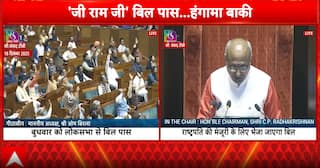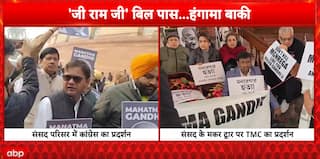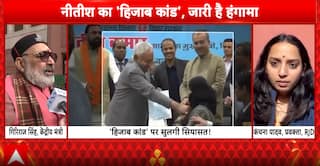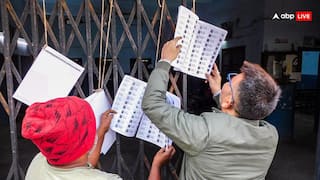Explorer
'Yeh Inquilab Hai, Sir': Indian Farmers And The Architecture Of Protest
The farmers of Punjab and Haryana, and increasingly of the rest of India, have taken to the streets and rattled the government—if ever so slightly.

Madhya Pradesh-based farmer leader Shiv Kumar Kakkaji, Bharatiya Kisan Union (BKU) spokesperson Rakesh Tikiat, and other farmer leaders address media after a meeting regarding the Centre's farm reform laws, near Singhu border in New Delhi. (Image: PTI)
This time of the year, one year ago, the Dadis of Shaheen Bagh stood up to the Indian state while most of the Indian middle class, which capitulated to the Modi government some years ago, looked on silently as one of the most remarkable nonviolent protests anywhere in the world was carried out with discipline over several months before the pandemic took over the lives of everyone and furnished the state with the pretext to send the Dadis back to their homes. Now, with the rebellion of the farmers, a new front has been opened in the battle of the country’s ordinary citizens against a wholly authoritarian government that does not only stifle dissent but reeks of the arrogance of power. “Power tends to corrupts”, the English politician and writer Lord Acton famously declared, “and absolute power corrupts absolutely.”
The farmers of Punjab and Haryana, and increasingly of the rest of India, have taken to the streets and rattled the government—if ever so slightly. The Shaheen Bagh protestors were pilloried as anti-national: since many were Muslim women, it was all too easy to paint them, and their supporters—students, liberals, human rights activists, and sometimes just people committed only to the notion that India must be hospitable to all—as people who were intent on destroying the social fabric of Indian society. Farmers, however, are not so easily dismissed, not that the BJP government has not tried to do so. It leaves the rants and loud screaming to its willing propagandists at Republic TV and some other media outlets—and of course to its massive army of trolls, who were quick off the mark with the preposterous allegation that, since many of the agitating farmers are Sikhs, the protestors are Khalistanis. This is a desperate attempt to communalize the protest and steer resentment against the farmers when everything points to the secular basis of the agitation. The BJP’s own senior leaders have taken recourse to a different language, arguing that farmers are misinformed about the legislation that was introduced in September and that, secondly, the opposition has deliberately led the farmers astray.
It was, of course, obscene but entirely in keeping with the style of colonial governance that the BJP has made all its own that the three laws that have profound implications for the agricultural sector against which the agitation is taking place were passed in the midst of the coronavirus pandemic. The bills were introduced without any consultation with farmers and swiftly passed, in the teeth of dissent from opposition parties whose demand that the bills be sent to a parliamentary committee for further deliberation was rejected out of hand, with the aid of the super majority that the BJP commands in the Indian parliament and gained the assent of President Ram Nath Govind in late September. To say that the government was “thoughtless” in putting forward bills that were bound to disturb Indian farmers at a time when people have been asked not to convene in public is a plausible way of putting it, since “thought”—the power of intellectual reasoning and a critical engagement with ideas—is wholly alien to those who presently wield power; but it is equally the case that this was done with the utmost deliberation, in the expectation that the massive upheaval in the lives of Indians wrought by the coronavirus pandemic was enough to keep the country distracted.
There is no denying the fact that the agricultural sector in India is in deep distress and badly in need of reform. Similarly, one can concede that the three farming laws, which “open up” the farming sector to corporate and financial interests, have defenders among some farmers (generally the rich ones), proponents of the market economy, and economists who are committed to neoliberal reforms. Though the Modi government has no appetite for “dialogue”, and has shown over the last seven years an adamant unwillingness to display anything that might even remotely be construed as a sign of weakness, it behooves anyone who is invested in the idea that genuine conversation and negotiation are at the heart of a politics that may be called democratic to keep an open mind towards those who support the radical restructuring of the agricultural sector that the government has now thrust upon Indian farmers. The substantive issue of what ails Indian farming and what may be done to resuscitate it and bring some hope to farmers is something that I will turn to in a companion essay; however, what is presently at stake is also the issue of the unimpeachable and non-derogable right of the people to wage nonviolent dissent.
It is precisely this right to dissent that the government has sought to abrogate. It is deplorable that farmers should be characterized as “terrorists”, just as it is deeply insulting to them to suppose that they are incapable of exercising their own judgment about how best they can advance their interests and what constitutes ethical political action. In an effort to stem the tide of tens of thousands of farmers who made their way towards Delhi, the government barricaded streets with trucks and dug up roads to prevent the passage of the tractors on which many farmers have traveled. In recent days, security forces have used tear gas and water cannons to disperse the farmers. These are, to put it mildly, the hallmarks of a government that has no tolerance for dissent. In the face of such barbarism, the resilience of farmers is inspiring if not heroic.
The country-wide protests against the Citizenship Amendment Act pointed to a growing awareness among the people of India, more particularly those who are dispossessed, disempowered, or marginalized in some substantive fashion, that they must now take protest to the streets. What is likewise striking about the present agitation is that, notwithstanding the attempt by the government to paint it as a movement of “misguided” farmers that is aided if not orchestrated by the opposition parties, it is an expression of the ground swell of opinion against a government that has pursued policies which have been ruinous to the vast majority of Indians. What is being witnessed in India is a new architecture of protest where the momentum has shifted to the people and the street has become the principal theatre of resistance. This architecture will require all the resources of the people of India if it is be sustained over a period of time to rebirth the Republic of India. I suspect that nothing encapsulates the promise of this moment as much as the remarks of the young Sikh actor Deep Sidhu, captured in a video, as he addresses and reprimands a uniformed security officer, “This is no way of handling such an agitation. Yeh inquilab hai, Sir. This is a revolution.”
(Vinay Lal is a writer, blogger, cultural critic, and Professor of History at UCLA)
[Disclaimer: The opinions, beliefs and views expressed by the various authors and forum participants on this website are personal and do not reflect the opinions, beliefs and views of ABP News Network Pvt Ltd.]
Follow Blog News on ABP Live for more latest stories and trending topics. Watch breaking news and top headlines online on ABP News LIVE TV
View More


























